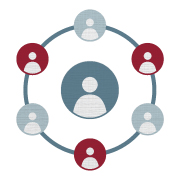
The Role of Marketing in Mergers & Acquisitions (The Tale of the Twinkie)
In 2012, Twinkie fans taught us an important lesson about marketing: When it comes to company valuation, customer loyalty is king.

 Especially in the B2B world, it’s no secret that word-of-mouth referrals are among the top ways professional services firms get leads and new business.
Especially in the B2B world, it’s no secret that word-of-mouth referrals are among the top ways professional services firms get leads and new business.
A study published by the American Marketing Association found that peer recommendations are 2.5 times more responsive than any other marketing channel. And another study found that referred customers generate higher margins and higher retention than other customers, making them more valuable in both the short and long run.
So why do so many providers miss the mark when it comes to getting referrals?
In order to excel at driving business through referrals, a business must do two things:
Adding value and delivering on client expectations provides the foundation for word-of-mouth marketing. Even the most robust referral system won’t generate results if you can’t offer an outstanding customer experience.
But if you’ve refined the customer experience piece, then creating and practicing an effective referral program can have major impacts on your bottom line. Below we’ve outlined the main steps to creating a referral system, and suggestions for putting it into practice. Remember, every business is unique, and your system will need to be tailored to the practices and key players in your marketing strategy.

Targeting the right people is essential for the success of your referral system.
Once you’ve identified your referrers, equip them with the right tools for success:
We understand that asking for referrals can be intimidating. You may worry that your client will think you're pushy or rude. Rest assured – after many years of consulting with a variety of different companies in a myriad of industries, we have only seen positive responses from polite, professional requests for referrals.
Develop a methodical system to ask for referrals from your clients. This will help your company realize an ongoing stream of prospects who come to you via word-of-mouth (the most powerful form of marketing):
When you show your referral sources that you appreciate their support, you’re ensuring their continued enthusiasm for sharing your message. There are many ways to recognize your referral sources:
In order to leverage your referral system for the best results, it’s critical to track your referrals and analyze key metrics. With the right amount of measurement, you can answer questions like:
Incorporating these elements into your marketing strategy will put you on track for an effective referral system that drives business and makes you more profitable. You can also tie it into your Customer Relationship Management (CRM) software so that your sales team is sure to input sales made as a result of referrals.
Just remember, a referral system won’t take you far if you can’t fulfill your brand promise. So while you’re thinking about ways to create or improve your referral system, also consider how to refine your offerings and to be more referable. Because the greatest way to generate more business is to give your customers something to talk about.
Get insights like this straight to your inbox.